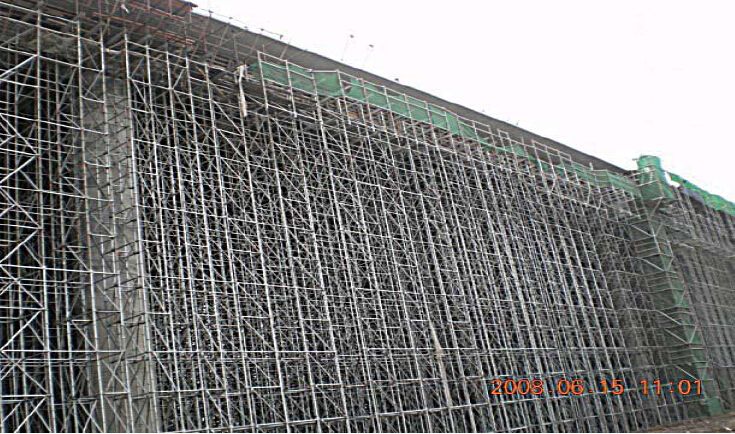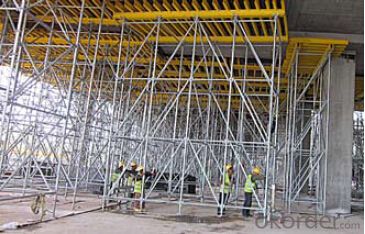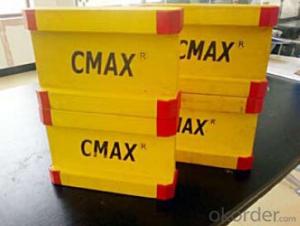Tower-Scaffolding for Formwork and Scaffolding systems
- Loading Port:
- Tianjin
- Payment Terms:
- TT OR LC
- Min Order Qty:
- 50 m²
- Supply Capability:
- 1000 m²/month
OKorder Service Pledge
Quality Product, Order Online Tracking, Timely Delivery
OKorder Financial Service
Credit Rating, Credit Services, Credit Purchasing
You Might Also Like
Tower Scaffolding
Shoring tower is an effective supporting system. It is easy to assemble and dismantlement, and
has excellent stability and bearing capacity. It has been widely used in the construction of industry
& residential buildings , bridges, tunnels and dam project, etc.
Characteristics:
◆ High degree of standardization.
◆ Easy storage and transportation
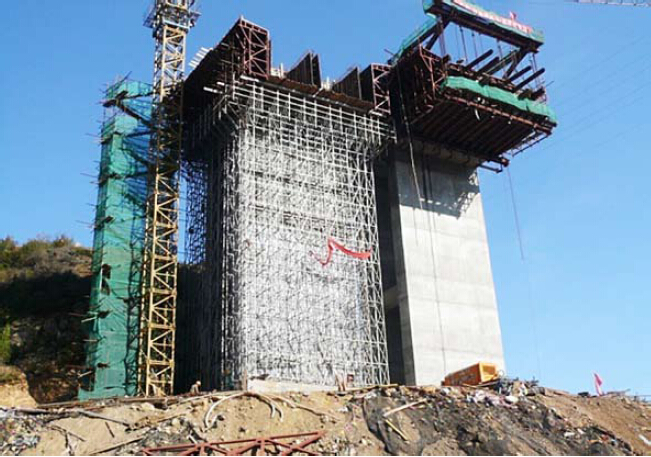
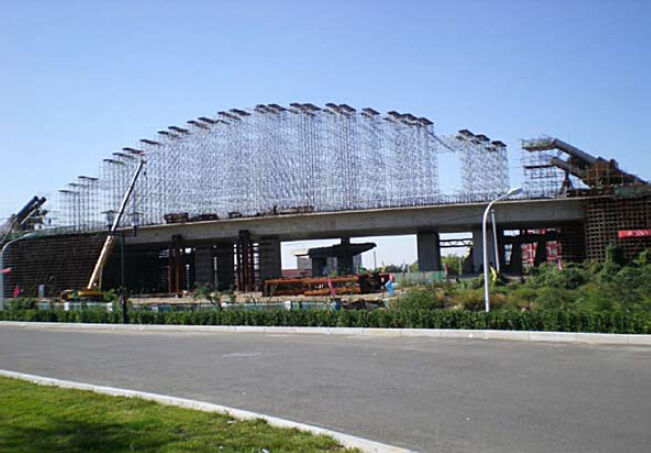
- Q: How does steel formwork handle formwork repositioning?
- Steel formwork is highly durable and flexible, making it ideal for handling formwork repositioning. Its sturdy construction allows for easy dismantling, transportation, and reassembly in new locations. Steel formwork systems typically consist of modular panels that can be easily adjusted and reconfigured to accommodate different shapes and sizes of concrete structures. This versatility and adaptability make steel formwork a preferred choice in construction projects where formwork repositioning is required.
- Q: Can steel formwork be used for office building construction projects?
- Yes, steel formwork can be used for office building construction projects. Steel formwork is a versatile and durable option for concrete construction that offers many advantages. It provides a high level of strength and stability, allowing it to withstand the pressures and loads encountered during the construction process. Steel formwork is also reusable, which makes it a cost-effective choice for large-scale projects like office buildings. Additionally, steel formwork allows for quick and efficient construction, as it can be easily assembled and disassembled, enabling faster turnaround times. Overall, steel formwork is a suitable option for office building construction projects due to its strength, durability, cost-effectiveness, and efficiency.
- Q: Can steel formwork be used for projects with limited formwork stripping time?
- Yes, steel formwork can be used for projects with limited formwork stripping time. Steel formwork is known for its durability and strength, making it suitable for various construction projects. Unlike traditional formwork materials such as wood or plywood, steel formwork can withstand higher pressures and loadings, allowing for faster construction cycles. Steel formwork is often used in high-rise buildings, bridges, and infrastructure projects where time is of the essence. Its rigid structure allows for quick assembly and disassembly, minimizing the time required for formwork stripping. Additionally, steel formwork can be reused multiple times, further reducing construction time and costs. Furthermore, steel formwork offers precise dimensional control, ensuring accurate and consistent results. This is particularly important for projects with limited formwork stripping time, as any errors or inconsistencies in the formwork can lead to delays and additional work. However, it is important to note that steel formwork may require skilled labor and specialized equipment for installation and removal. Therefore, proper planning and coordination are crucial to ensure efficient and safe use of steel formwork for projects with limited formwork stripping time.
- Q: What are the cost implications of using steel formwork?
- The cost implications of using steel formwork can vary depending on several factors. Initially, the upfront cost of steel formwork may be higher compared to other alternatives like timber or plastic. However, steel formwork offers higher durability and longevity, reducing the need for frequent replacements or repairs. This can result in long-term cost savings as steel formwork is more resistant to wear and tear. Additionally, steel formwork allows for faster construction cycles due to its sturdiness and ease of use, potentially reducing labor costs. Overall, while the initial investment may be higher, the long-term benefits and reduced maintenance expenses make steel formwork a cost-effective choice in many construction projects.
- Q: Are there any specific quality control measures for steel formwork installation?
- Yes, steel formwork installation has specific quality control measures in place to guarantee correct installation and adherence to required standards. Before installation, one key quality control measure involves inspecting the steel formwork for damages, defects, or deviations from specifications. Any issues discovered during the inspection must be addressed and resolved before proceeding with installation. Verifying the dimensions and alignment of the steel formwork is another quality control measure. This ensures that the formwork is fabricated accurately and aligned properly with the structure. Inaccurate dimensions or misalignment can cause issues during concrete pouring and impact the final structure's quality. Furthermore, quality control measures include checking the stability and strength of the steel formwork. This involves confirming that the formwork is adequately braced and supported to withstand the concrete's pressure. It's crucial to ensure that the formwork can bear the load without deforming or failing. Moreover, closely monitoring the installation process itself is essential to ensure compliance with required procedures and standards. This includes verifying that the formwork is securely fastened and all connections are properly made. Any deviations from installation procedures should be promptly addressed and corrected. Regular inspections and audits should be conducted throughout the installation process to track progress and identify potential issues. This allows for timely interventions and corrections, ensuring that the steel formwork installation meets required quality standards. In conclusion, specific quality control measures are crucial for steel formwork installation to ensure the structure's integrity and safety. By implementing these measures, potential issues or defects can be identified and resolved early on, minimizing the risk of expensive rework or structural failures.
- Q: What are the considerations when designing steel formwork for foundations?
- When designing steel formwork for foundations, there are several key considerations that need to be taken into account. Firstly, the formwork needs to be strong and durable enough to withstand the weight and pressure of the wet concrete being poured into it. This requires selecting the appropriate grade and thickness of steel to ensure structural integrity. Secondly, the formwork should be designed to be easily assembled and disassembled, as well as adjustable to accommodate different foundation shapes and sizes. This can help save time and effort during the construction process. Additionally, the formwork should be designed with proper reinforcement and bracing to prevent any potential deformation or collapse under the weight of the wet concrete. This ensures the safety of workers and the stability of the foundation. Furthermore, considering the ease of formwork removal is essential. The design should facilitate the easy removal of the formwork after the concrete has cured, without causing any damage to the foundation or leaving any unwanted marks. Lastly, the cost-effectiveness of the formwork design should be considered. This includes evaluating the cost of materials, labor, and maintenance, as well as the potential for reuse or recycling of the formwork components. Overall, designing steel formwork for foundations requires careful consideration of factors such as strength, durability, assembly/disassembly, reinforcement, bracing, ease of removal, and cost-effectiveness.
- Q: How does steel formwork affect the overall construction site safety measures?
- Steel formwork can have a significant impact on the overall construction site safety measures in several ways. Firstly, steel formwork is known for its high strength and durability, which ensures stability and structural integrity during the construction process. This reduces the risk of accidents such as collapses or structural failures, enhancing the safety of workers and the site as a whole. Additionally, steel formwork offers better fire resistance compared to other types of formwork materials. This characteristic can prevent or slow down the spread of fire, providing extra time for workers to evacuate the site safely and for emergency services to respond effectively. It also reduces the risk of fire-related accidents, protecting both human lives and the surrounding environment. Another safety benefit of steel formwork is its ability to withstand extreme weather conditions, such as strong winds or heavy rain. This resilience reduces the likelihood of formwork damage or failure, ensuring the safety of workers and preventing potential accidents caused by adverse weather. Furthermore, steel formwork is often designed with built-in safety features, such as handrails and platforms, to provide secure working surfaces for construction workers. These features allow workers to perform their tasks safely at heights, reducing the risk of falls and injuries. Lastly, steel formwork is reusable and requires minimal maintenance, which contributes to the overall site safety. The use of reusable formwork reduces waste and clutter, creating a cleaner and more organized working environment. This, in turn, minimizes the risk of accidents caused by tripping or falling over debris. In conclusion, steel formwork positively affects the overall construction site safety measures by providing stability, fire resistance, weather resistance, built-in safety features, and a cleaner working environment. These benefits reduce the risk of accidents, ensure the safety of workers, and contribute to the successful completion of construction projects.
- Q: Can steel formwork be used for both vertical and horizontal concrete structures?
- Yes, steel formwork can be used for both vertical and horizontal concrete structures. Steel formwork is highly versatile and can be easily adjusted and assembled to create various shapes and sizes for different structures. It provides strong support, stability, and durability, making it suitable for both vertical walls and horizontal slabs. Steel formwork also offers excellent dimensional accuracy, ensuring precise concrete placement and alignment. Additionally, steel formwork is reusable, which makes it a cost-effective option for construction projects that require repetitive use of formwork systems.
- Q: How does steel formwork handle different concrete slump loss over time?
- Steel formwork is highly durable and capable of effectively managing various degrees of concrete slump loss over time. Slump loss refers to the reduction in workability or consistency of concrete as a result of factors like evaporation, hydration, or temperature changes. One advantage of steel formwork is its ability to withstand high pressure and retain its shape, even when the concrete experiences slump loss. This is because steel formwork is rigid and offers robust reinforcement to the concrete structure. Unlike other types of formwork, such as wooden or plastic formwork, steel formwork does not easily warp or deform, even if the concrete becomes less fluid. Moreover, steel formwork is designed for reusability, enabling it to be easily dismantled and utilized for multiple construction projects. This is particularly advantageous when dealing with concrete slump loss over time. If the concrete slump decreases, the steel formwork can be easily adjusted or modified to accommodate changes in shape or dimensions. Furthermore, steel formwork delivers a smooth and uniform surface finish to the concrete structure. This is crucial because any imperfections or irregularities in the formwork can impact the final appearance and quality of the concrete. With steel formwork, the risk of surface defects or blemishes is minimized, regardless of any slump loss that may occur. In conclusion, steel formwork is well-suited for managing different degrees of concrete slump loss over time due to its durability, rigidity, and adjustability. It ensures that the concrete structure maintains its shape and integrity while providing a smooth and uniform surface finish.
- Q: How does steel formwork contribute to better site organization?
- Steel formwork contributes to better site organization by providing a durable and reusable system for creating concrete structures. Its accuracy, strength, and ease of assembly allow for efficient and precise construction, reducing the need for on-site adjustments or modifications. This results in a well-organized and streamlined construction process, saving time and resources. Additionally, steel formwork's versatility enables the creation of complex shapes and designs, enhancing the aesthetic appeal of the site.
Send your message to us
Tower-Scaffolding for Formwork and Scaffolding systems
- Loading Port:
- Tianjin
- Payment Terms:
- TT OR LC
- Min Order Qty:
- 50 m²
- Supply Capability:
- 1000 m²/month
OKorder Service Pledge
Quality Product, Order Online Tracking, Timely Delivery
OKorder Financial Service
Credit Rating, Credit Services, Credit Purchasing
Similar products
Hot products
Hot Searches
Related keywords


